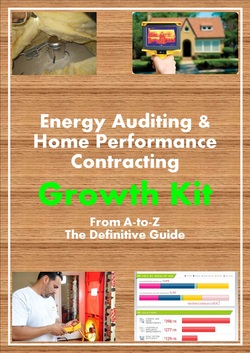Pass the BPI Exam the First Time!
FREE HERS RATER PRACTICE EXAMPUT YOUR HOME PERFORMANCE BUSINESS ON ROCKET FUELENERGY AUDITOR NEWSLETTERGet the only Energy Auditor Marketing Newsletter with monthly strategies and tactics to grow your home performance business.
|
1. Understanding Airflow in BuildingsQuick Terms:
Terms in depth:
1. CFM - cubic feet per minute is how airflow is measured. It is the combination of a home's holes (leakage) and the pressure difference between the inside and outside. Energy auditors and HERS Raters use a blower door to take the pressure difference in a home between the inside and outside at a standard 50 Pascals. 2. CFM50 - cubic feet per minute at 50 Pascals (Pa for short). This is the airflow (in Cubic Feet per Minute) needed to create a change in building pressure of 50 Pascals. Energy auditors take blower door readings to measure a home's air and duct leakage. To standardize air leakage measurements, each home is pressurized or depressurized (it doesn't technically matter, what is important is the pressure difference, the rest depends on your showmanship, troubleshooting skills and the house itself) to 50 Pascals. When you run a blower door, you will have two readings. One will tell you the pressure the house is at (you dial this in by adjusting the fan speed up or down to 50 Pa, this will never change), the other reading will show you the house leakage at 50 Pa, in CFM (this number will vary and will need to be compared to the minimum ventilation requirements for the house to tell you if the house is too tight, too leaky and how much you can seal the home before it becomes a potential H&S hazard). A duct blaster is another piece of equipment to measure only duct leakage. It is the most accurate way to measure duct leakage, but only required in HERS Ratings for Energy Star Homes. A duct blaster is like a mini blower door and the home is taken to 25 Pa of pressure difference, not 50 Pa like a blower door.
3. ACHn - natural air changes per hour. This is the number of times the air is changed in a home (or space) per hour under natural conditions. This term is not unique to us energy auditors and is used by engineers to design make-up air for buildings. Each building has a target ACH it has to reach per code. For homes, ACH is a nice term for homeowners to hear and relate to, rather than CFM50. One ACH means that all the air in the house is replace one time every hour.
To calculate ACHn you can use a very general rule of thumb and divide the ACH50 by 20, or you can use a do a multi-point blower door test. To do a multi-point blower door set the CFM to 15, 20, 25, 35, etc up CFM60 and plot on a graph the leakage (what you measured) on the y-axis and the pressure (CFM15, 25, etc) on the x-axis. Then you can extrapolate to find the actual leakage at any pressure. Generally, the rule of divide by 20 is good enough for a quick calculation, if you use software with your blower door, the extrapolation is what the computer uses to give ACHn. Calculate ACH504. ACH50 - the number of air changes per hour at 50 Pascals. This is second way a blower door results are reported (the other being CFM50). To calculate the ACH50 first find the building volume by taking the square footage of the home and multiplying it by the average ceiling height. Then take the CFM50 x 60 / volume to get ACH50.
An ACH50 of 19 is very high and you know the house has a lot of room for improvements. An ACH50 of 1 or less is a very tight, possible Energy Star Certified home. 5. FPM - feet per minute. Blowometers and anemeters measure the velocity of air in FPM. To get the flow rate, what advanced energy auditors and HVAC specialist are really concerned about in order to diagnose poor airflow. Given a room size, ceiling height and orientation we can know the exact flow rate of supply air coming out the ductwork. If we can measure it (using the tools above) and adjust it (using baffles, dampeners and some duct re-design) we can solve a homeowner's comfort issues. To convert FPM to CFM, multiply the FPM by the area of the duct... If you have a 10" flex duct, the area would be ((10" x 1/12) / 2))^2 x 3.14. If you have a 10 x 6 rectangular sheet duct, the area would be 10 x 6. FPM is irrelevant in airflow without the area of the ductwork so don't just go off the FPM if you start diagnosing poor airflow.
External Link:http://www.buildingenergysolutions.com/pdfs/bdtest.pdf
Next Section
1b. Principals of energy, air & moisture
1c. Combustion science
|


